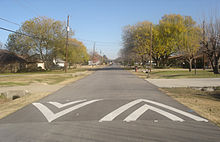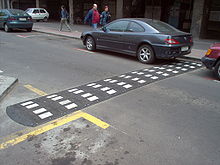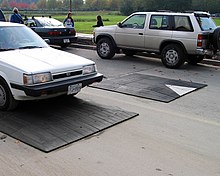Speed bump
- For the cartoon series, see Speed Bump. For speed changes in cinematography, see speed ramping.







Speed bumps are the common name for a family of traffic calming devices that use vertical deflection to slow motor-vehicle traffic in order to improve safety conditions. Variations include the speed hump (or speed ramp), speed cushion, and speed table.
The use of vertical deflection devices is widespread around the world, and they are most commonly found where vehicle speeds are statutorily mandated to be low, usually 40 km/h (25 mph), or 8 to 16 km/h (5.0 to 9.9 mph) in car parks.[citation needed] Although speed bumps are very effective in keeping vehicle speed down, their use is sometimes controversial as they can cause noise and possibly vehicle damage if taken at too great a speed. Poorly designed speed bumps are often found in private car parks[citation needed] (too tall, too sharp an angle for the expected speed), and can be hard to negotiate in vehicles with low ground clearance, such as sports cars, even at very slow speeds. Speed bumps can also pose serious hazards to motorcyclists and bicyclists if not clearly visible, though in some cases a small cut across the bump allows those vehicles to pass through without impediment. Speed bumps cost between $50–200, but have to be replaced after wear.[1]
Composition
Each of these devices can be made from a variety of materials, including asphalt, concrete, recycled plastic, metal, or vulcanized rubber. Several trade-offs must be made when selecting the material for a new speed cushion. Traditionally most vertical deflection devices have been constructed of asphalt or concrete; these can be difficult to construct precisely, but have more permanence and greater effect in slowing traffic, due to the material's rigidity and durability.
Rubber products are pre-shaped to standardized sizes and thus consistently meet industry standards. It is also easier and to install or remove preformed rubber devices; prefabricated rubber cushions must simply be assembled and bolted down to meet standard specifications, which is particularly beneficial when a city wants to test streets before deciding where to keep the devices.[citation needed] The simple installation process also allows for relocation during the winter when snow is a concern, which prevents damage to the humps by snowplows.[citation needed]
History
On June 7, 1906, The New York Times reported on an early implementation of what might be considered speed bumps in the U.S. town of Chatham, New Jersey, which planned to raise its crosswalks five inches above the road level: "This scheme of stopping automobile speeding has been discussed by different municipalities, but Chatham is the first place to put it in practice".[2] The average automobile's top speed at the time was around 30 miles per hour (48 km/h).[citation needed]
Arthur Holly Compton was a physicist and winner of the Nobel Prize in physics in 1927 for his discoveries resulting in major changes in electromagnetic theory. He is commonly known for his work on the Compton Effect with X-rays. He also invented what he called "traffic control bumps," the basic design for the speed hump, in 1953. Compton began designs on the speed bump after noticing the speed at which motorists passed Brookings Hall at Washington University in St. Louis, Missouri, where he was chancellor.[3]
The British Transport and Road Research Laboratory published a comprehensive report in 1973 examining vehicle behavior for a large variety of different bump geometries.[4] At the time speed humps were not permitted on public roads but had been installed on private roads.
According to a publication by the Institute of Transportation Engineers, the first speed bump in Europe was built in 1970 in the city of Delft in the Netherlands.[5]
Speed bumps
Speed bumps are also known as a sleeping policeman in British English and Caribbean English and a judder bar in New Zealand English. A speed bump is a bump in a roadway with heights typically ranging between 3 and 4 inches (7.6 and 10.2 cm). The depth of speed bumps is typically less than or near to 1 foot (30 cm); contrasting with the wider speed humps, which are typically 10 to 14 feet (3.0 to 4.3 m) in depth.[6][7]
Speed bumps of various sizes can be placed on a road, with two four-foot or six-foot devices on it with a space on either side. The space is for drainage, and to allow emergency vehicles (with a wider tire spacing than passenger cars and trucks) to pass over without hitting the speed bumps. A speed bump may also be connected across the entire road surface.
Disadvantages
Local authorities have cited disadvantages to speed bumps:
- The city of Modesto in California, U.S. produced a fact sheet which contains the following disadvantages:[8]
- Slow response time of emergency vehicles;
- May divert traffic to parallel residential streets; and
- There is a possibility of increased noise and pollution for residents living immediately adjacent to the speed bumps.
- The English town of Eastleigh states the following as disadvantages:[9]
- Can cause damage to some vehicles;
- Can increase traffic noise, especially when large goods vehicles pass by;
- Signs, street lighting and white lines are all required and may be visually intrusive;
- Can cause discomfort for drivers and passengers; and
- Can cause problems for emergency services and buses.
- Drivers are distracted by the bumps, therefore ignoring other hazards such as children; and
- Humps can impede or slow emergency vehicle access to areas.
Other sources argue that speed bumps:
- Increase pollution as traffic travels in a lower gear using significantly more fuel per mile;
- Are a substitute for active enforcement;
- Increase noise by both traversing over the bumps and by using more engine revs than normal;
- Cause spinal damage[10] or aggravate chronic backache.
In 2003, the chairman of the London Ambulance Service, Sigurd Reinton was reported as claiming that delay due to speed bumps was responsible for up to 500 avoidable deaths from cardiac arrest each year. He later denied the statement.[11]
In Sweden, an evaluation of spinal stress in bus drivers against ISO 2631-5 required on health grounds:[12]
- bus drivers to avoid certain streets until the humps were modified; and
- a reduction of the maximum acceptable speed to 10 km/h on one street for drivers encountering 150 humps in a day.
Dynamic speed bumps
Dynamic speed bumps differ from conventional speed bumps in that they only activate if a vehicle is traveling above a certain speed. Vehicles traveling below this speed will not experience the discomfort of a conventional speed bump. Dynamic speed bumps may allow the passage of emergency vehicles at higher speeds.
In one design, a rubber housing is fitted with a pressure relief valve which determines the speed of a vehicle. If the vehicle is traveling below the set speed, the valve opens allowing the bump to deflate as the vehicle drives over it, but it remains closed if the vehicle is traveling too fast. The valve can also be set to allow heavy vehicles, such as fire trucks, ambulances, and buses to cross at higher speeds.[13][14]
Speed humps
A speed hump (also called a road hump, or undulation,[15] and speed ramp) is a rounded traffic calming device used to reduce vehicle speed and volume on residential streets. Humps are placed across the road to slow traffic and are often installed in a series of several humps in order to prevent cars from speeding before and after the hump. Common speed hump shapes are parabolic, circular, and sinusoidal.[15]
Generally, speed humps are 12 to 14 feet (3.7 to 4.25 m) in length and span the width of the road. The height of humps ranges from 3 to 4 inches (7.5 to 10 cm).[15] The length and height of the speed humps determine the speed at which traffic will travel over the devices. Shorter lengths and greater heights slow cars most drastically. When placed in a series 350–550 feet (100–170 m) apart, humps will reduce 85 percentile speeds by 8–10 mph (13–15 km/h).[16]
A warning sign notifies motorists before humps. Humps generally have pavement markings to enhance visibility and a taper edge near the curb to allow a gap for drainage.[15]
Speed humps are used in locations where very low speeds are desired and reasonable.[17] Speed humps are typically placed on residential roads and are not used on major roads, bus routes, or primary emergency response routes. Placement is generally mid-block between intersections.
Results
Typical speeds resulting from speed humps are 10–20 mph (15–30 km/h). Studies show an average 18% reduction in traffic volume and an average 13% reduction in collisions.[15]
Comparison to speed bumps
While similar to speed bumps, humps are less aggressive than speed bumps at low speeds and are used on actual streets, as opposed to bumps which are primarily placed in parking lots.[18] While speed bumps generally slow cars to 5–10 mph (8.0–16.1 km/h), humps slow cars to 10–20 mph (16–32 km/h). The narrow nature of speed bumps often allows vehicles to pass over them at high speed while only perturbing the wheels and suspension, hardly affecting the vehicle cab and its occupants. The relatively long slopes of speed humps gradually accelerate the entire vehicle in vertical direction, causing the perturbation of the cab to become progressively more severe at higher speeds.[19]
Criticisms
One criticism of speed humps is their effect on emergency vehicles. Response time is slowed by 3–5 seconds per hump for fire trucks and fire engines and up to 10 seconds for ambulances with patients on board.[15] Speed humps are thus usually not placed on primary response routes. Speed cushions may be placed on these routes instead.
Occasionally, there is an increase in traffic noise from braking and acceleration of vehicles on streets with speed humps, particularly from buses and trucks. Other effects include increased vehicle fuel consumption and emissions as well as increased wear and tear on brakes, engine and suspension components.
Damage caused by snow plows during the winter months is an additional concern.
Heavy sedans, trucks, and SUVs are less affected by speed humps, and may not have to slow down as dramatically.
Thin cuts are sometimes placed in the middle of a hump in order to allow bicycle traffic to pass through. However, forcing cyclists to take a particular line on the road compromises their ability to position themselves safely according to the other traffic on the road at the time.
Speed cushions
Speed cushions are designed as several small speed humps installed across the width of the road with spaces between them. They are generally installed in a series across a roadway resembling a split speed hump. The design of speed cushions forces cars to slow down as they ride with one or both wheels on the humps. However, the wider axle of fire engines (and other large vehicles) allows them to straddle the cushions without slowing down. Ambulances might have the same advantage when they are American style vehicles. In Europe and Australia, where vehicles like Mercedes Sprinter are most frequently used as ambulance vehicles, there is no advantage. In these jurisdictions, narrower speed cushions are sometimes placed at more frequent intervals to allow ambulances to pass while driving over the centre line.
Advantages
Speed cushions have several distinct advantages over similar traffic calming devices. Many municipalities are challenged by opposition to speed humps and speed tables since they slow down emergency vehicles. Speed cushions address this problem by allowing larger vehicles to straddle the cushion without slowing down. This is also an advantage for buses, as lower floor vehicles can sometimes ground out on traditional humps.
Speed cushions are also often less costly than speed humps or tables while most cities report them to be just as effective. In some jurisdictions, narrower speed cushions are placed at more frequent intervals to allow ambulances to pass while driving over the centre line. Large trucks (e.g., UPS, FedEx) are also not slowed down.
Speed tables
A speed table (or flat top hump or raised pedestrian crossing) is designed as a long speed hump with a flat section in the middle. Speed tables are generally long enough for the entire wheelbase of a passenger car to rest on top.[20] The long, flat design allows cars to pass without slowing as significantly as with speed humps or cushions.[21] Because they slow cars less than similar devices, speed tables are often used on roads with typical residential speed limits.
Speed tables can also be signed as pedestrian crossings.
Results
Typical speeds resulting from 22 feet (7 m) speed tables are 20–30 miles per hour (32–48 km/h). One sample of 8 sites found a 45% decrease in accidents per year with the use of speed tables.[21]
Advantages
Speed tables are effective in calming traffic on streets where the speed limit needs to be maintained rather than slowing cars more significantly. Traffic speed, volumes, and accidents have been shown to decrease with the use of tables. Although not as responsive to emergency vehicles as speed cushions, speed tables cause less of a delay than humps and are typically preferred by fire departments over speed humps.[20]
In the UK
In the United Kingdom, vertical deflection in highways for the purpose of traffic calming typically takes one of the following forms:
- Road humps are the most common variety, and are usually round-topped.
- Speed tables, a type of hump with a central plateau which is both long and broad, and which may include a pedestrian crossing, are preferred by some emergency services and bus operators.
- Speed cushions, a raised portion of road with a flat top only extending over part of the carriageway's width, are used singly, in a pinch point, or in pairs or triples.
- Rumble strips, uneven road surfaces, are now only used in rural areas and retail parks because of the noise.
The Department for Transport defines the regulations for the design and use of road humps.[22]
Opposition
Speed bumps in some areas have been removed after protests by local residents. Such protests cite the lack of any consultation as one factor.[23] For example, complaints from Derby residents, prompted the removal of 146 speed bumps from streets at a cost of £460,000. Similar incidents have been reported elsewhere in the UK.[24] UK news sources reported a cyclist being killed in a crash while attempting to avoid a speed bump.[25]
See also
References
- ^ "Catalog: Speed Bumps & Humps". Speed Bumps and Humps. Retrieved 29 March 2012.
- ^ "Democratic Rate Plan Favored by Roosevelt [and other news]". New York Times. 1906-03-07. p. 3.
- ^ "Original Traffic control sketch made by Compton in 1953" (PDF). Washington University Libraries. Retrieved 2014-03-14.
- ^ Road humps for the control of vehicle speeds by G.R. Watts, TRRL Laboratory Report 597,1973
- ^ Klaus Schlabbach. "Traffic Calming in Europe" (PDF). Institute of Transportation Engineers. Retrieved 2014-03-14.
- ^ ITE. "Traffic Calming Measures". Institute of Transportation Engineers.
- ^ TrafficCalming.org. "Speed Humps (Road Humps, Undulations)". Fehr & Peers.[dead link]
- ^ "Speed Hump Fact Sheet" (PDF). City of Modesto. Retrieved 2014-03-14.
- ^ "Speed Limits and Reduction: Speed Humps". Eastleigh Borough Council. [dead link]
- ^ "Like it or lump it: Is the speed hump here to stay?". BBC. July 22, 2003. Retrieved January 4, 2010.
- ^ "Transport Committee Minutes 11/12/2003". London Assembly. Retrieved 2014-03-14.
- ^ Dr Anders Brandt & MSc Johan Granlund, Swedish Road Administration (2008). "Bus Drivers' Exposure To Mechanical Shocks Due To Speed Bumps" (PDF). Society for Experimental Mechanics, IMAC XXVI Conference and Exposition on Structural Dynamics. Retrieved June 2, 2010.
- ^ "Smart speed bumps reward safe drivers". New Scientist.[dead link]
- ^ English, Shirley (November 11, 2005). "Smart' road hump will smooth the way for safe drivers". London: The Times. Retrieved May 23, 2010.[dead link]
- ^ a b c d e f ITE. "Traffic Calming Measures – Speed Hump". Institute of Transportation Engineers.[dead link]
- ^ Peter Partington. "Speed Humps". Trafficcalming.net. Retrieved 2014-03-14.
- ^ trafficcalming.org. "Speed Humps". Fehr and Peers.[dead link]
- ^ "SPEED BUMPS AND SPEED HUMPS". www.cga.ct.gov. Retrieved 9 June 2013.
- ^ "Speed Humps vs. Speed Bumps". www.maine.gov. Retrieved 9 June 2013.
- ^ a b ITE. "Traffic Calming Measures". Institute of Transportation Engineers.[dead link]
- ^ a b trafficcalming.org. "Speed Tables". Fehr and Peers. Retrieved 2014-03-14.
- ^ "Highways (Road Humps) Regulations 1999 (replacing the 1996 regulations)" (PDF). UK Department of Transport.
- ^ "Speed humps dumped after protest". Auto Express.
- ^ "Bumps: Britain gets the hump". London: The Times. October 19, 2003. Retrieved May 23, 2010.
- ^ "Crash victim's family may file civil action". Strathspey & Badenoch Herald.[dead link]
External links
- Questions and Answers about Speed Humps[dead link]
- City of Austin Speed Cushion Description[dead link]
- UK Department for Transport Speed Cushion Description[dead link]
- London Assembly, London's got the hump, April 2004. An examination of speed humps conducted by the London Assembly’s Transport Committee.
- Institute of Transportation Engineers Speed Table Description
- Speed Humps Protect Children from Injury
- Speed Hump Description[dead link]
